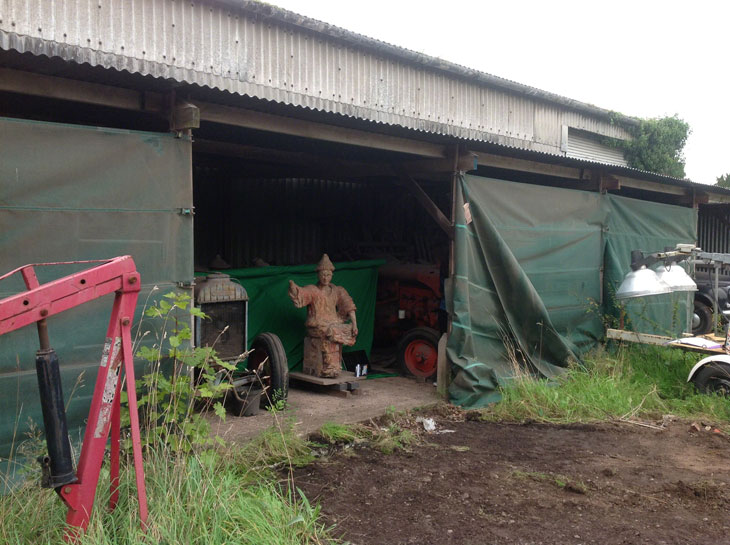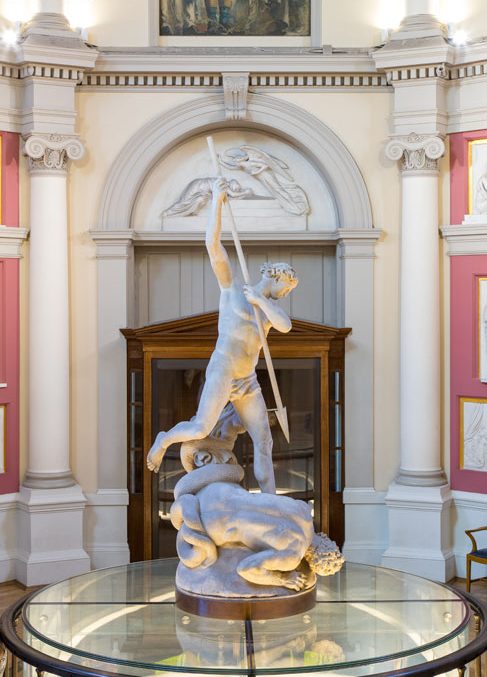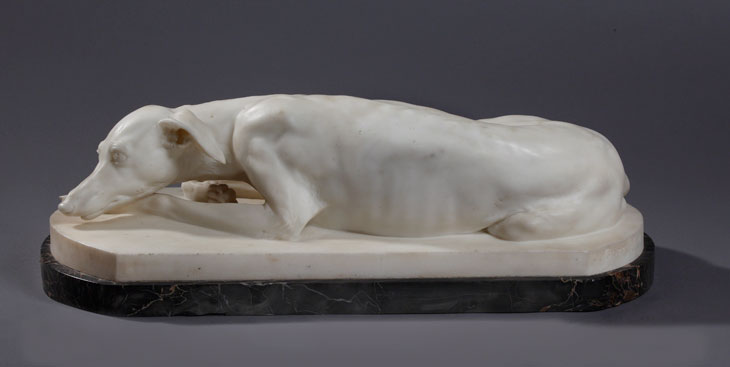The UK is home to many celebrated sculptures, from the Angel of the North in Gateshead to the bronze lions at the foot of Nelson’s Column in Trafalgar Square. But these famous monuments are just the tip of the iceberg. Tens of thousands of sculptural works in the UK are publicly owned. Some are on display in civic spaces, museums, and galleries; many are in storage. Without proper documentation, lesser-known pieces effectively become undiscoverable to people who do not live near them or know where to look for them.
By 2020, this problem should be consigned to the past. Art UK, which last year launched a comprehensive, free digital catalogue of every oil painting in public ownership, has formally embarked on an equivalent project for sculpture. Building on the work of the Public Monuments and Sculpture Association (PMSA), one of Art UK’s main partners, just shy of 170,000 sculptures and monuments will be photographed, catalogued, and presented online over the next three years.

This sculpture of a Chinese tea-taster once adorned a tea warehouse in Stafford. It’s been in storage since the building was demolished in the 1960s and will soon be moved to a new indoor location. Photo: Art UK
Until now, the focus has been on defining the limits of the project and securing funding for it (the Heritage Lottery Fund has put up £2.8m, with a further £1m coming from other sources including Arts Council England, the Scottish government, the Esmée Fairbairn Foundation and Stavros Niarchos Foundation). The database will encompass all sculpture made in the last 1,000 years, and will include high and low reliefs as well as freestanding works. The recording process will now begin in earnest, with the recruitment of 67 local project managers, and the training of 750 volunteers assisted by the Royal Photographic Society. The first records will go online early next year, and will be fully integrated into the existing Art UK website.
The accompanying education programme will include a series of ‘Sculpture Around You’ events, bringing sculptures to public centres and transport hubs, and ‘Masterpieces in Schools’, which will transport objects to the classroom. Young people will be invited to create films with the help of the arts organisation Culture Street and the Royal British Society of Sculptors, while the charity VocalEyes will offer events for blind and partially sighted people. Professional training will be available to photography students, state school pupils and museum employees, in addition to the 750 project volunteers. Finally, Factum Foundation is to create 3D images and reproductions of selected artworks – as an education and research tool, but also perhaps a commercial one (the Art UK shop is set to open this autumn following a successful pilot scheme).

Saint Michael Overcoming Satan (1819–24), John Flaxman. Photo: UCL Art Museum © Mary Hinkley
While such engagement programmes are no doubt a prerequisite of lottery funding, collaboration and knowledge-sharing have always been fundamental to Art UK. The digital platform was born out of the efforts of the Public Catalogue Foundation (PCF), which published comprehensive catalogues of the nation’s paintings between 2002 and 2012. Putting these records online has dramatically increased their public impact and potential for scholarly and crowd-sourced research, and a number of significant reattributions and revelations have already been made as a result.
It was this ability to stimulate both public and academic engagement that led Art UK to win Apollo’s Digital Innovation of the Year Award in 2016, and there is plenty of reason to believe in the public appetite for a similar scheme for sculpture. The widespread interest in the recent rediscovery of Peter Laszlo Peri’s Sunbathers from the Festival of Britain is a case in point, as are the debates generated by the 3D-printed replica of Palmyra’s triumphal arch that was unveiled in Trafalgar Square last year. The fact that some 50 per cent of visitors to the Art UK website are from overseas is also significant. Few other countries boast a national art database of comparable size and accessibility, and the UK’s museums and monuments can only gain from increasing international exposure.

Greyhound (1827), Joseph Gott. Temple Newsam, Leeds. Photo: Art UK / Leeds Museums and Galleries. Taken during photography testing in 2013
It took a decade to digitise the 212,000-or-so paintings that are now online at Art UK. The sculpture project is expected to take three years, and will involve tens of thousands of people. If Art UK and its partners succeed in building on their existing momentum, the UK will gain not just an online resource, but a stronger and wider network of people across the country with a stake in the nation’s cultural heritage – something we need now more than ever.
Visit the Art UK website for further details about the scheme.

Public sculpture in the UK is about to become more visible
Nymph Removing a Thorn from a Greyhound’s Foot Temple Newsam, Leeds. Photo: Art UK / Leeds Museums and Galleries
Share
The UK is home to many celebrated sculptures, from the Angel of the North in Gateshead to the bronze lions at the foot of Nelson’s Column in Trafalgar Square. But these famous monuments are just the tip of the iceberg. Tens of thousands of sculptural works in the UK are publicly owned. Some are on display in civic spaces, museums, and galleries; many are in storage. Without proper documentation, lesser-known pieces effectively become undiscoverable to people who do not live near them or know where to look for them.
By 2020, this problem should be consigned to the past. Art UK, which last year launched a comprehensive, free digital catalogue of every oil painting in public ownership, has formally embarked on an equivalent project for sculpture. Building on the work of the Public Monuments and Sculpture Association (PMSA), one of Art UK’s main partners, just shy of 170,000 sculptures and monuments will be photographed, catalogued, and presented online over the next three years.
This sculpture of a Chinese tea-taster once adorned a tea warehouse in Stafford. It’s been in storage since the building was demolished in the 1960s and will soon be moved to a new indoor location. Photo: Art UK
Until now, the focus has been on defining the limits of the project and securing funding for it (the Heritage Lottery Fund has put up £2.8m, with a further £1m coming from other sources including Arts Council England, the Scottish government, the Esmée Fairbairn Foundation and Stavros Niarchos Foundation). The database will encompass all sculpture made in the last 1,000 years, and will include high and low reliefs as well as freestanding works. The recording process will now begin in earnest, with the recruitment of 67 local project managers, and the training of 750 volunteers assisted by the Royal Photographic Society. The first records will go online early next year, and will be fully integrated into the existing Art UK website.
The accompanying education programme will include a series of ‘Sculpture Around You’ events, bringing sculptures to public centres and transport hubs, and ‘Masterpieces in Schools’, which will transport objects to the classroom. Young people will be invited to create films with the help of the arts organisation Culture Street and the Royal British Society of Sculptors, while the charity VocalEyes will offer events for blind and partially sighted people. Professional training will be available to photography students, state school pupils and museum employees, in addition to the 750 project volunteers. Finally, Factum Foundation is to create 3D images and reproductions of selected artworks – as an education and research tool, but also perhaps a commercial one (the Art UK shop is set to open this autumn following a successful pilot scheme).
Saint Michael Overcoming Satan (1819–24), John Flaxman. Photo: UCL Art Museum © Mary Hinkley
While such engagement programmes are no doubt a prerequisite of lottery funding, collaboration and knowledge-sharing have always been fundamental to Art UK. The digital platform was born out of the efforts of the Public Catalogue Foundation (PCF), which published comprehensive catalogues of the nation’s paintings between 2002 and 2012. Putting these records online has dramatically increased their public impact and potential for scholarly and crowd-sourced research, and a number of significant reattributions and revelations have already been made as a result.
It was this ability to stimulate both public and academic engagement that led Art UK to win Apollo’s Digital Innovation of the Year Award in 2016, and there is plenty of reason to believe in the public appetite for a similar scheme for sculpture. The widespread interest in the recent rediscovery of Peter Laszlo Peri’s Sunbathers from the Festival of Britain is a case in point, as are the debates generated by the 3D-printed replica of Palmyra’s triumphal arch that was unveiled in Trafalgar Square last year. The fact that some 50 per cent of visitors to the Art UK website are from overseas is also significant. Few other countries boast a national art database of comparable size and accessibility, and the UK’s museums and monuments can only gain from increasing international exposure.
Greyhound (1827), Joseph Gott. Temple Newsam, Leeds. Photo: Art UK / Leeds Museums and Galleries. Taken during photography testing in 2013
It took a decade to digitise the 212,000-or-so paintings that are now online at Art UK. The sculpture project is expected to take three years, and will involve tens of thousands of people. If Art UK and its partners succeed in building on their existing momentum, the UK will gain not just an online resource, but a stronger and wider network of people across the country with a stake in the nation’s cultural heritage – something we need now more than ever.
Visit the Art UK website for further details about the scheme.
Unlimited access from just $16 every 3 months
Subscribe to get unlimited and exclusive access to the top art stories, interviews and exhibition reviews.
Share
Recommended for you
When artists fall through the cracks of history
Was it concrete or Communism that caused modernist sculptor Peter Laszlo Peri’s slide into obscurity?
The search is on for England’s missing public sculptures
Public sculpture was one marker of an ambitious, aspirant and generous society, the kind of world that we urgently need to be reminded of
Wolsey’s Angels: the V&A seeks to acquire four important Renaissance sculptures
Cardinal Wolsey commissioned them, Henry VIII seized them, and now the V&A wants to preserve them